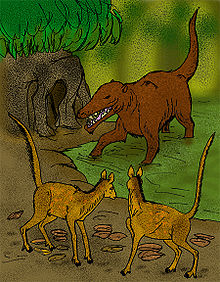Diacodexis
Extinct genus of Artiodactyls From Wikipedia, the free encyclopedia
Extinct genus of Artiodactyls From Wikipedia, the free encyclopedia
Diacodexis is an extinct genus of small herbivorous mammals belonging to the family Diacodexeidae[1][2][3] that lived in North America, Europe and Pakistan from 55.4 mya to 46.2 mya and existing for approximately 9.2 million years.
| Diacodexis | |
|---|---|
 | |
| Diacodexis pakistanensis and Pakicetus inachus | |
| Scientific classification | |
| Domain: | Eukaryota |
| Kingdom: | Animalia |
| Phylum: | Chordata |
| Class: | Mammalia |
| Order: | Artiodactyla |
| Family: | †Diacodexeidae |
| Genus: | †Diacodexis Cope, 1882 |
| Species | |
| |

Diacodexis is the oldest known even-toed ungulate. In life, it would have resembled a modern duiker, measuring about 50 centimetres (1.6 ft) in body length, but with a much longer tail. Unlike most later species of artiodactyl, it still had five toes on each foot, although the third and fourth toes were already elongated. It may also have had small hooves on each toe. Its teeth suggest that it was a herbivorous browser.[4]
As suggested by its long legs, Diacodexis is believed to have been fast-running, capable of leaping relatively far.
Diacodexis was widespread, with fossils having been found in Pakistan, Europe, and North America.
Seamless Wikipedia browsing. On steroids.
Every time you click a link to Wikipedia, Wiktionary or Wikiquote in your browser's search results, it will show the modern Wikiwand interface.
Wikiwand extension is a five stars, simple, with minimum permission required to keep your browsing private, safe and transparent.